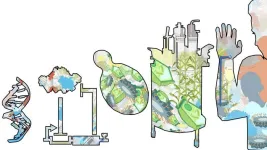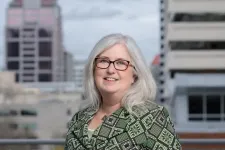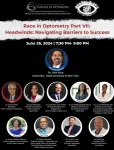(Press-News.org) The field of synthetic biology, the science of manipulating biology, has a lot of “cooks in the kitchen,” which has both helped it flourish and made it unusually difficult to create a cohesive, consistent curriculum for students at every level of study. Each discipline involved — from chemical engineering to ethics — has a unique approach to teaching and literature, which creates inconsistencies between what scientists learn.
Now, Northwestern University researchers propose a new way to teach synthetic biology that uses different levels of organization — starting at the molecular scale and growing to the societal scale — to teach core principles and a holistic view of developing sustainable synthetic biology technologies. The approach incorporates components from many disciplines, allowing people from many different backgrounds to access synthetic biology education.
A paper detailing the framework was published yesterday (June 26) in the journal Nature Communications.
“Early versions of synthetic biology courses lacked a conceptual foundation,” said Julius Lucks, a synthetic biology expert and lead author. “From an educational perspective, you saw a kind of hodgepodge depending on which department you were in. We set ourselves the challenge of trying to figure out, how can you merge all those disciplines, somehow develop a common framework and create a common language?”
Lucks is a professor of chemical and biological engineering at Northwestern’s McCormick School of Engineering and co-director of the Center for Synthetic Biology (CSB).
When genetic engineering emerged in the 1970s, the idea to reuse, repurpose and reconfigure biological systems to address challenges in society — the core of synthetic biology — became possible. With CRISPR’s advent around 1990, synthetic biology was popularized and, without any curriculum to turn to, faced an identity problem.
“One of the biggest problems we saw in our students and labs are that they tend to be focused on a very specific problem,” said Ashty Karim, a Northwestern research assistant professor of chemical and biological engineering and the paper’s first author.
“For example, if you're looking at how CRISPR works, you might be studying the localized protein machinery that makes edits to the DNA. But if you're going to create a technology based on CRISPR, there are many other important facets than the molecular scale workings. How does it work in the context of a cell or a population of cells within someone's body across different tissues? How does that interact with current healthcare systems? These are discussions that we need to be having and might influence the science that we do.”
Karim is the director of research at CSB and a core member of its faculty.
From this came the idea of breaking down biology into scales, developed originally from a conversation about how most introductory biology courses present a continuum that moves from DNA to tissue to organism. There are emerging behaviors that appear at different levels of organization; society behaves differently from an organism, and so on. Synthetic biology, according to the paper, can be broken down into five components: molecular, circuit/network, cellular, biological communities and societal.
Key to the proposed framework is the presence of robust ethics at each scale.
By piloting the curriculum with undergraduate and graduate students at Northwestern, the authors said they found that different core principles, like thermodynamics and kinetics, mapped onto different scales naturally. For instance, do you need to understand a principle all the time? Or can you “ignore” it up to a certain scale?
Curriculum should also be underpinned by case studies that help learners analyze how engineering choices made at one scale affect biological function at another, assemble potential solutions to global challenges across scales and identify the impact of synthetic biology on societal goals and ethical issues. Case studies can also be tailored to the institution or instructor implementing the curriculum.
Presenting the approach to classes has been greatly successful, according to Lucks and Karim, who both said the concept “clicked” for students even the first time they taught the course. The scales concept has been so successful that in fact, the Northwestern Center for Synthetic Biology uses it to organize its cutting-edge collaborative research.
The researchers also hope the curriculum can be implemented much more broadly and have provided resources and ideas that others may use to adapt the approach to their needs and interests.
The development of the deconstruction approach was supported by the National Science Foundation through the SynBAS NRT program (grant number 2021900) and by the Bachrach Family Foundation.
END
Northwestern researchers propose a new, holistic way to teach synthetic biology
Approach promises to bridge scientists across disciplines to solve society’s biggest challenges
2024-06-27
ELSE PRESS RELEASES FROM THIS DATE:
Is ChatGPT the key to stopping deepfakes? Study asks LLMs to spot AI-generated images
2024-06-27
BUFFALO, N.Y. — When most people think of artificial intelligence, they’re probably thinking of — and worrying about — ChatGPT and deepfakes. AI-generated text and images dominate our social media feeds and the other websites we visit, sometimes without us knowing it, and are often used to spread unreliable and misleading information.
But what if text-generating models like ChatGPT could actually spot deepfake images?
A University at Buffalo-led research team has applied large language models (LLMs), including OpenAI’s ChatGPT and Google’s Gemini, toward spotting deepfakes of ...
NIH funds critical center in Detroit to lead efforts to investigate and mitigate health impacts of community-voiced chemical and non-chemical stressors
2024-06-27
DETROIT — Wayne State University received a four-year, $5.2 million P30 environmental health sciences core center (EHSCC) grant from the National Institute of Environmental Health Sciences (NIEHS) of the National Institutes of Health (NIH) in support of the “Center for Urban Responses to Environmental Stressors (CURES).”
This grant will allow the interdisciplinary CURES team of researchers, educators and community partners to continue its ongoing quest to understand the basis for urban environmental health disparities and the human health impact of environmental exposure to complex chemical and non-chemical stressors in Detroit's urban landscape. CURES is one of ...
TREC director Jennifer Dill named editor-in-chief of Transportation Research Record
2024-06-27
Jennifer Dill, director of Portland State University's Transportation Research and Education Center (TREC), has been named the inaugural editor-in-chief of the Transportation Research Record (TRR). The TRR—the flagship journal of the National Academies of Sciences, Engineering, and Medicine’s Transportation Research Board (TRB)—is one of the most cited and prolific transportation journals in the world, offering wide coverage of transportation-related topics.
While maintaining her current role as the director of TREC, Dill will begin her duties ...
SUNY College of Optometry focuses on diversity and inclusion in optometry
2024-06-27
New York, NY— This week, the State University of New York (SUNY) College of Optometry held a continuation of their annual webinar series, Race in Optometry which started in 2020. Aimed at fostering a national dialogue that leads to necessary changes to increase diversity in the optometric profession and education, the annual webinar focused on Headwinds: Navigating Barriers to Success. This webinar was the seventh installment in a series hosted annually around the Juneteenth holiday by the College’s Office of Continuing Professional ...
Taxing shared micromobility: How cities are responding to emerging modes, and what's next
2024-06-27
Shared micromobility (including shared electric scooters and bikes provided by private companies) is one of the newest transportation options that has come to cities in the last several decades. A new report explores the different ways cities charge shared micromobility companies to operate, and how these funds are used.
In the newly released report, John MacArthur of Portland State University, Kevin Fang of Sonoma State University and Calvin Thigpen of Lime examine data from 120 cities in 16 countries around the world. They also conducted a survey of cities’ shared micromobility ...
June research news from the Ecological Society of America
2024-06-27
The Ecological Society of America (ESA) presents a roundup of four research articles recently published across its six esteemed journals. Widely recognized for fostering innovation and advancing ecological knowledge, ESA’s journals consistently feature illuminating and impactful studies. This compilation of papers explores the potential for pines to establish in pine-free interior Alaska, internet sleuthing to assess birds’ extinction risk and more, showcasing the Society’s commitment to promoting cutting-edge research that furthers our understanding ...
Antibody-drug conjugate highly effective in preventing recurrence in patients with early stage HER2+ breast cancer, trial finds
2024-06-27
A year of treatment with a medicine made of an antibody and chemotherapy drug has proven highly effective in preventing stage 1 HER2-positive breast cancer from recurring in patients, a team led by Dana-Farber Cancer Institute researchers has found.
In a clinical trial involving 512 patients with the earliest stage of breast cancer that tested positive for the HER2 protein, 97% of those treated with trastuzumab emtansine (T-DM1) after surgery were alive and free of invasive cancer five years after treatment. The results, published online today in the Journal of Clinical Oncology, suggest that T-DM1 is a reasonable treatment approach for this stage 1 population, the study authors ...
Ephemeral streams, often overlooked, are major contributors to US river flow and water quality
2024-06-27
Ephemeral streams – temporary streams that only flow after rainfall or snowmelt – contribute more than 50% of the flow in downstream river systems and likely have a major influence on water quality across the United States, according to a new modeling study. The findings show how important ephemeral streams are for the transport of water and pollution into larger, more permanent water bodies. Excluding these streams from coverage under the U.S. Clean Water Act, say the authors, would significantly limit federal authority to protect downstream water quality. Ephemeral streams, which flow only in direct response to precipitation and are disconnected from groundwater sources, ...
From a Pompeii-like ash burial in Morrocco: Pristine 3D anatomy of Cambrian trilobites
2024-06-27
Thanks to being rapidly entombed in volcanic ash – in a “Pompeii-like” process – Cambrian-age trilobites’ anatomy is more discernable than ever, via exquisitely preserved fossils. The fossils uncovered in Morrocco are reported in a new study that reveals microscopic details including of trilobite appendages and the trilobite digestive system. Trilobites are perhaps the most well-known creatures that lived during the Cambrian Period. These extinct marine arthropods’ hard exoskeleton lends itself to high fossilization potential, facilitating the identification of more ...
Novel epigenic editor, CHARM, enables brain-wide prion protein silencing
2024-06-27
In a new study in mice, researchers introduce “CHARM,” a compact and versatile epigenetic editor that can be used to silence prion protein throughout the brain. The tool provides a path towards an effective first-line treatment for patients with deadly prion disease as well as other neurodegenerative diseases caused by the toxic buildup of unwanted proteins. Prion disease – a suite of devastating neurodegenerative disorders that result in rapid-onset dementia and death – is caused by misfolding of the prion protein, PrP, to form toxic aggregates that result in neuronal death. Previous research in mice has shown that removing PrP ...
LAST 30 PRESS RELEASES:
Numbers in our sights affect how we perceive space
SIMJ announces global collaborative book project in commemoration of its 75th anniversary
Air pollution exposure and birth weight
Obstructive sleep apnea risk and mental health conditions among older adults
How talking slows eye movements behind the wheel
The Ceramic Society of Japan’s Oxoate Ceramics Research Association launches new international book project
Heart-brain connection: international study reveals the role of the vagus nerve in keeping the heart young
Researchers identify Rb1 as a predictive biomarker for a new therapeutic strategy in some breast cancers
Survey reveals ethical gaps slowing AI adoption in pediatric surgery
Stimulant ADHD medications work differently than thought
AI overestimates how smart people are, according to HSE economists
HSE researchers create genome-wide map of quadruplexes
Scientists boost cell "powerhouses" to burn more calories
Automatic label checking: The missing step in making reliable medical AI
Low daily alcohol intake linked to 50% heightened mouth cancer risk in India
American Meteorological Society announces Rick Spinrad as 2026 President-Elect
Biomass-based carbon capture spotlighted in newly released global climate webinar recording
Illuminating invisible nano pollutants: advanced bioimaging tracks the full journey of emerging nanoscale contaminants in living systems
How does age affect recovery from spinal cord injury?
Novel AI tool offers prognosis for patients with head and neck cancer
Fathers’ microplastic exposure tied to their children’s metabolic problems
Research validates laboratory model for studying high-grade serous ovarian cancer
SIR 2026 delivers transformative breakthroughs in minimally invasive medicine to improve patient care
Stem Cell Reports most downloaded papers of 2025 highlight the breadth and impact of stem cell research
Oxford-led study estimates NHS spends around 3% of its primary and secondary care budget on the health impacts of heat and cold in England
A researcher’s long quest leads to a smart composite breakthrough
Urban wild bees act as “microbial sensors” of city health.
New study finds where you live affects recovery after a hip fracture
Forecasting the impact of fully automated vehicle adoption on US road traffic injuries
Alcohol-related hospitalizations from 2016 to 2022
[Press-News.org] Northwestern researchers propose a new, holistic way to teach synthetic biologyApproach promises to bridge scientists across disciplines to solve society’s biggest challenges




